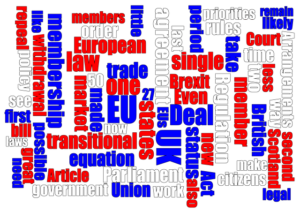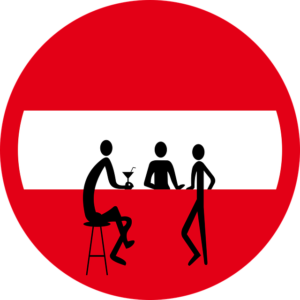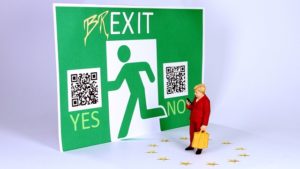| Date | Event |
23 June 2016 |
 Britain votes to leave the EU (Brexit) (turn out 72.2%, remain 48.1%, leave 51.9%) What is Brexit? Brexit is an abbreviation for “British exit,” referring to the UK’s decision on 23 June 2016 referendum to leave the EU. |
24 June 2016
|
Cameron resigns as a Prime Minister
|
13 July 2016 |
May becomes a Prime Minister
|
24 January 2017
|
Supreme Court rules that Government cannot trigger Article 50 without an Act of Parliament but does not have to consult the devolved legislatures in Scotland, Wales and Northern Ireland |
26 January 2017
|
The European Union (Notification of Withdrawal) Bill by the Government to allow the UK to start the process of leaving the EU (after the Supreme Court ruled legislation is necessary) |
16 March 2017
|
European Union (Notification of Withdrawal) Act with the legal power to formally begin the Brexit process by notifying the European Council of the UK’s intention to leave the EU |
29 March 2017 |
The UK invokes Article 50
What is Article 50? Article 50 is a clause in the EU’s Lisbon Treaty explaining the steps, which a country needs to take if it wishes to leave the EU. |
26 June 2017
|
EU citizens in the UK. May announces the Government’s proposals regarding ways of protecting the rights of EU citizens living in the UK after Brexit. |
8 November 2017 |
 Birth of the backstop What is the backstop? Also, knowns as the “Irish backstop” is ‘a safety net’ in UK-EU Brexit negotiations. It’s meant to make sure that the Irish border remains open irrespective of the outcome of the UK and the EU’s after Brexit negotiations. It is intended to protect the Good Friday Agreement/Belfast Agreement to keep an open border between Northern Ireland and Ireland.
|
19 March 2018 |
The backstop solution. The UK has agreed that the “backstop” guarantee to avoid a hard Irish border should be included in the draft Brexit treaty. |
14 November 2018 |
The Withdrawal Agreement – a deal agreed between the UK and the EU but it still has to pass House of Commons.
What is the Withdrawal Agreement? This is a draft treaty between the EU) and the UK, setting the terms of the withdrawal of the UK from the EU.
|
15 January 2019 – 22 May 2019 |
 MPs rejected May’s Withdrawal Agreement (432 to 202, a majority of 230) |
12 March 2019 |
May loses the Withdrawal Agreement for the second time (by 149) |
29 March 2019 |
The UK’s original leave date is missed due to disagreement on the Withdrawal Agreement |
10 April 2019 |
The EU agrees to extend the deadline until 31 October 2019 (flextention)
What is Flextenton? It is ‘the flexible extension’ policy allowed by the EU for the UK to leave the EU. There were two flextentions: No1 to 22 May 2019 (agreed in March 2019) No2: to 31 October 2019 (agreed on 5 April 2019) |
24 July 2019 |
May resigns
Why do Members of Parliament resign? A total of 54 MPs have resigned since 1979. Remarkably, 53.7% of them have done so in the last ten years. The resignations happen for a number of reasons. The most common ones are scandals, party political differences and offers of new jobs. 31 MPs have left to have a fresh start at another place. 16 have accepted job offers in the private sector. Another 12 exchanged their national seats for local ones – as police and crime commissioners, mayors, or to serve on local assemblies. |
23 July 2019 |
Boris Johnson becomes a Prime Minister
|
28 August 2019 |
The Parliament of the UK was ordered to be prorogued (suspended) by Queen Elizabeth II for 5 weeks from 9/12 September 2019 until 14 October 2019.
What is Prorogation? It is an act in UK constitutional law that is usually used to mark the end of a parliamentary session.
|
10 September 2019 |
The beginning of the Parliament prorogation period, causing chaos and strong reaction by the opposition at the House of Commons.
Why was the opposition against the UK prorogation? Since Parliament was to reopen just 17 days before the UK’s scheduled departure from the UK (on 31 October 2019), the prorogation was considered Boris Johnson’s attempt (the Prime Minister) to avoid parliamentary scrutiny of the Government’s Brexit plans in the final weeks leading up to Brexit. |
24 September 2019 |
The UK supreme court unanimously rules against the suspension of parliament. Parliament returns next day
Why did the UK supreme court rule that the prorogation was unlawful? This is because it ‘has the effect, of frustrating or preventing, without reasonable justification, the power of Parliament to carry out its constitutional functions as a legislature and as the body responsible for the supervision of the executive’. For this reason, it found that proroguing for five weeks, rather than the normal four to five days, in the run-up to the major constitutional change on 31 October was unlawful. |
2 October 2019
|
Boris Johnson proposes an alternative to the backstop.
|
17 October 2019 |
 The EU and the UK reach a new Brexit agreement that would avoid a hard border What is the New Agreement? Most of the changes to the Withdraw Agreement negotiated by May with EU on 14 November 2018 related to the Irish border after Brexit. They agreed that the whole of the UK will leave the EU customs union. The EU customs union is an agreement between EU countries not to charge taxes on goods coming from other EU countries, and to charge the same tax as each other on goods coming from outside the EU. Afterwards, the UK will be free to negotiate trade deals with other countries in the future as it wishes. Also, de jure, there will be a customs border between Northern Ireland (which stays in the UK) and the Republic of Ireland (which stays in the EU). De facto, there will not be any checks on the border. · The actual checks will be at ‘points of entry’ into Northern Ireland. · Taxes will only have to be paid on goods being moved from Great Britain to Northern Ireland if those products are considered ‘at risk’ of then being transported into the Republic of Ireland. If ‘at risk’ goods are not sent from Northern Ireland to the EU, the UK will refund the money. · There will not be any checks for individual travellers. No taxes to be paid by individuals sending goods to other people. This rule is only for businesses.
|
28 October 2019 |
The EU Ambassadors agreed to a further Brexit extension to 31 January 2020 |
31 January 2020 |
Current Brexit date, after Prime Minister Boris Johnson’s Brexit deal was backed by MPs |
1 July 2020 |
The last day that the UK and EU can, under the terms of the Brexit agreement, request an extension of the standstill transition period by up to one or two years. |
31 December 2020 |
The transition period ends
What is Brexit Transition Period? The Brexit transition is a period agreed in the UK-EU withdrawal agreement in which the UK will no longer be a member of the EU but will continue to be subject to EU rules and remain a member of the single market and customs union.
|
31 October 2024 |
If the transition period ends on 31 December 2020, this is the last date that the UK must allow the Northern Ireland Assembly to vote on whether to continue with arrangements keeping Northern Ireland tied to EU customs rules under the latest Brexit deal.
What is the Northern Ireland Assembly? It is the devolved legislature for Northern Ireland. Northern Ireland Assembly has the power to make laws in a wide range of areas, including housing, employment, education, health, agriculture and the environment. It meets at Parliament Buildings, Belfast. What is Devolution? It is the statutory delegation of powers from the central government of a sovereign state to govern at a subnational level, such as a regional or local level. |

Further Help
And finally, if you are thinking of submitting a visa application, you will significantly increase your chances for success by understanding the rules and the process of your visa application. I, therefore, created a number of online courses to help you do exactly that. Knowledge will give you confidence and may help avoid refusal. For more information about the courses CLICK HERE.
